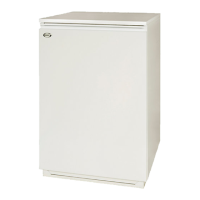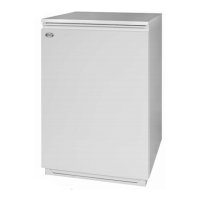Page 46 Section 12: Fault Finding
C BURNER NOT OPERATING
First, set either hot water or heating to ON
Is the ‘BURNER’ indicator
lit?
NO Refer to ‘initial checklist’ for guidance.
NO Continue to next check.
Is the ‘BURNER’ indicator
ashing?
YES
Fast or slow ash.
First, set boiler ‘ON/OFF’ switch to ‘OFF’.
Wait 5 seconds
Then set ‘ON/OFF’ switch back to ‘ON’.
If the ‘BURNER’ indicator
continues ashing.
Slow ash
(once every 2 seconds):
Indicates a possible fault
with the PCB (relay).
Replace PCB
Is the ‘BURNER’ indicator
lit?
YES
PCB is supplying voltage to
the burner - but the burner
is not working.
Check all electrical connections to burner control box.
Check for 230V at L and N terminals in control box.
Is ‘lockout’ button (on control box) lit?
If yes: press ‘lockout’ button to reset burner.
If burner does not re, refer to Section 12.4 (burner fault nding).
12.3 POOR HOT WATER CHECKLIST
Always check the basics before changing parts.
Burner
If heat energy input is
incorrect: heat energy
output will be incorrect.
Poor heat input = poor hot
water.
Check nozzle is correct size.
Check oil pump pressure is correct.
Check combustion is correctly set.
DHW pump
Plate heat exchanger
requires water circulation
from primary store to
operate.
Check pump speed setting: it must be maximum.
Check pump valves are fully open.
Thermistors
DHW ‘store’ and CH ‘ow’
thermistors must detect
temperatures correctly.
Check both are fully inserted in their pockets.
Water ow rate at hot tap
Excessive ow rate
exceeds heat input from
burner.
Excessive ow rate = poor
hot water.
Check ow rate at tap.
Combi 21 = 12 litres/minute maximum.
Combi 26 = 15 litres/minute maximum.
Combi 36 = 18 litres/minute maximum.
Water pressure
Excessive pressure has a
major inuence on ow rate.
Check standing and operating water pressure.
2 bar minimum standing pressure required.
8 bar maximum standing pressure.
If greater than 8 bar; t a pressure reducing valve on the cold supply to the boiler.
1 bar minimum dynamic pressure required.
Water condition
Scale forming in the plate
heat exchanger = poor heat
transfer in plate = poor hot
water temperature.
Check for scale in the plate heat exchanger.
Replace plate heat exchanger if necessary.
In hard water areas some form of anti-scale device or water softener must be tted.
NOTE: Faults due to hard water scaling are not covered by the product guarantee.
Thermostatic blending valve
Must be correctly set to
provide optimum hot water.
Check if blending valve is scaled up (refer to ‘water condition’ above).
Clean or replace as necessary.
! NOTE !
For an overview of the fault diagnostic capabilities built
into the circulating pumps that come installed in all Vortex
Pro Combi models, please refer to Appendix A1 or A2,
as required, at the back of this installation and servicing
manual.
